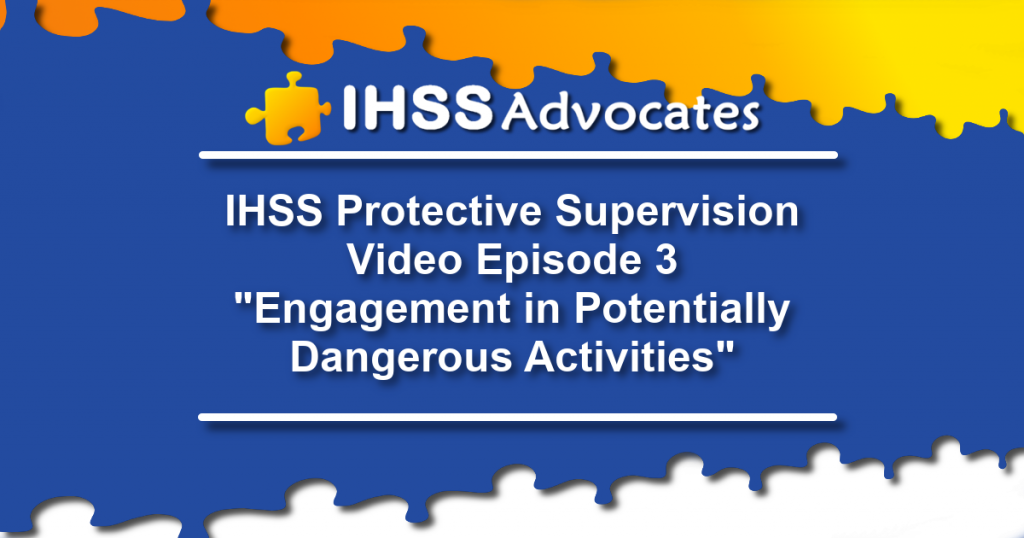Engagement in Potentially Dangerous Activities
How to establish that your nonself-directing & mentally-impaired child is likely to engage in potentially dangerous activities. What does and does not qualify for Protective Supervision. Featuring IHSS advocate Larry Rosen of IHSSadvocates.
If you need any assistance, you are welcome to join our support group at: IHSS Advocacy Group
Key Points:
If the minor is mentally impaired/mentally ill and nonself-directing, is he/she likely to engage in potentially dangerous activities? Consider here whether the minor retains the physical ability to put him/herself at risk of harm. If the answer is no, then the minor is not eligible for Protective Supervision under the Calderon v. Anderson court decision, and Protective Supervision should not be granted.
The county should document that because the child is not likely to engage in potentially dangerous activities, the minor does not meet the Garret criteria of needing more supervision than another minor of the same age without a mental impairment/mental illness.
Protective Supervision consists of observing recipient behavior and intervening as appropriate in order to safeguard the recipient against injury, hazard, or accident.
Protective Supervision shall not be authorized…when the need is caused by a medical condition and the form of the supervision required is medical.
Protective Supervision recipients must be physically capable of harming themselves. In Calderon v. Anderson (1996), the court held that the plaintiff was not entitled to Protective Supervision under the IHSS Program because his physical condition made it impossible for him to engage in any activities that would require observation or preventable intervention, and Protective Supervision was not available merely to provide constant oversight in anticipation of environmental or medical emergencies.
However, a mentally impaired or mentally ill individual who is bedridden, or in a wheelchair, is not necessarily incapable of engaging in activities that would require observation or preventative intervention under Protective Supervision. The specific factual circumstances of the individual must be considered when determining whether she/he has the physical ability to engage in potentially dangerous activities.
For example, a mentally impaired or mentally ill bedridden individual may still have the physical ability to pull at his/her G-tube that requires observation or intervention under Protective Supervision.
The risk or harm is different than the types of medical emergencies/medical conditions for which Protective Supervision is not available under MPP 30-757.172, such as the potential to fall because the mentally impaired/mentally ill person experiences poor balance.
For example, in Norasingh v Lightborne (2014) 299 Cal. App. 4th 740 176 Cal. Rptr. 3d 868, it states: Protective Supervision is available for those IHSS beneficiaries who are nonself-directing, in that they are unaware of their physical or mental condition and therefore, cannot protect themselves from injury, and who would most likely engage in potentially dangerous activities. (Calderon, supra, 45 Cal. App. 4th at p. 616). Prior cases analyzing the availability of Protective Supervision have listed examples of “potentially dangerous” conduct for which supervision many be authorized, including playing with matches; immersing electrical appliances in water; wandering away from home; cooking; smoking a cigarette; and engaging in self-destructive behavior such as temper tantrums and head-banging against a wall. (Ibid.) However, pursuant to CDSS regulation, protective supervision is only available “for observing the behaviour of nonself-directing, confused, mentally impaired, or mentally ill persons”. (MPP, 30-757.171.) Thus, it cannot be authorized “when the need is caused by a medical condition and the form of the supervision required is medical.” (MPP, 30-757.172(b).)
It is CDSS’ policy that a person does not have to suffer actual injury to be eligible for Protective Supervision, but only have a history of a propensity for placing him/herself in danger. For example, a person with a documented history of nonself-direction, who has a tendency to open the front door and start walking away, does not necessarily have to make it into the street in order for this to be considered potentially hazardous behavior.
Doctors can fill out IHSS forms such as the “Assessment of Need for Protective Supervision (SOC 821)”, discussing the mentally impaired child’s potentially dangerous behavior.
A parent can keep a journal of their mentally impaired child’s potentially dangerous behavior.
IEP, Regional Center, and therapist reports relating to the mentally impaired child can be reviewed for examples of potentially dangerous behavior.
If needed, treating clinicians and/or school personal can provide eyewitness examples of the mentally impaired child’s potentially dangerous behavior.
Watch Episode #2
Nonself-Direction in Approval of Protective Supervision
Have you been denied Protective Supervision? We can help!
Click here to request a free advocate evaluation of your case.
If you need any assistance, you are welcome to join our support group at: IHSS Advocacy Group

